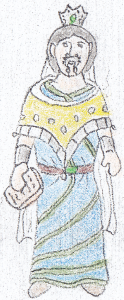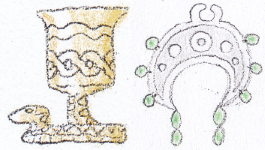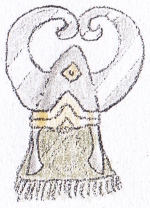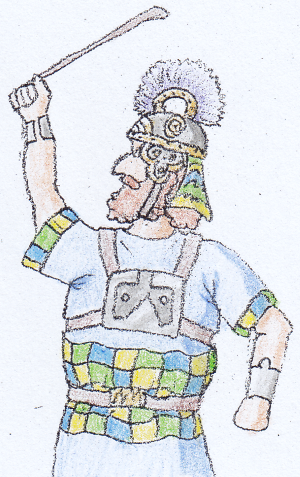Þekkals
Þekkalic: Þekkalhein
Dalran: Þekkalere
Húlpakric: Þekkalö
Enmohó: Tekkalhen
Akalúric: Þekkalhin
The þekkals1 are one of cultures within the empire of Dalra in eastern Emlas, whose traditional territory covers the lower Namazús River in the eastern Zúdalikí Desert, in the southeastern part of the empire. They are renowned for their scholars, engineers and artists, and their former capital of Kilí now functions as the economic capital of Dalra.
Merma became the dominant power in eastern Emlas in the chaos that followed the end of bronze age, despite being occupied by the akalúrans for a time, and were rivals of the Vanrans who had their own empire up in the Zamra Mountains. The þekkals' success depended largely on their engineering skills, which allowed them to control the flow of water in the otherwise turbulent Namazús River.
The þekkals were eventually conquered by the Dalrans hailing from the mountains, but þekkal culture is highly regarded by the dalran royalty, who have adopted many of their customs, art and architecture.
Jewelry is traditionally made of silver, turquoise and emeralds, and often has lunar imagery, particularly nose-jewels. A wealthy þekkal lady wearing traditional clothing
The þekkals1 are one of cultures within the empire of Dalra in eastern Emlas, whose traditional territory covers the lower Namazús River in the eastern Zúdalikí Desert, in the southeastern part of the empire. They are renowned for their scholars, engineers and artists, and their former capital of Kilí now functions as the economic capital of Dalra.
History
During bronze age, the þekkals and their cousins the Akalúrans subsisted on hunting and shepherding in the desert, where they traded with the powerful Ilaxarans and other people at the Namazús River in exchange for letting their sheep graze along its banks. When ilaxaran culture declined after years of drought, the þekkals invaded their land and founded the kingdom of Merma along the lower river, while the akalúrans claimed its upper part.Merma became the dominant power in eastern Emlas in the chaos that followed the end of bronze age, despite being occupied by the akalúrans for a time, and were rivals of the Vanrans who had their own empire up in the Zamra Mountains. The þekkals' success depended largely on their engineering skills, which allowed them to control the flow of water in the otherwise turbulent Namazús River.
The þekkals were eventually conquered by the Dalrans hailing from the mountains, but þekkal culture is highly regarded by the dalran royalty, who have adopted many of their customs, art and architecture.
Culture
Appearance
Þekkal clothing is generally similar to that of the akalúrans, consisting of a short, belted tunic for men and a longer dress and poncho for women, both usually made of wool. Wealthy women often wear a more complicated wrap-around dress, a small tiara with cloth attached to it, and sheepskin shoes.Jewelry is traditionally made of silver, turquoise and emeralds, and often has lunar imagery, particularly nose-jewels. A wealthy þekkal lady wearing traditional clothing
Art
Þekkal gold- and silversmiths are quite famous in eastern Emlas for their craftsmanship, using both traditional motifs as well foreign styles such as dalran and enan ones. Snakes are a common theme, as their ability to shed their old skin makes them a symbol of long life, even immortality, among the þekkals. Þekkal cup and nose-jewelCuisine
Traditional þekkal cuisine is mostly based on wheat and -to lesser extend- maize, dates, leeks and onions, mutton, fish and waterfowl. Maize is mostly used to brew corn beer, a process which is exclusively done by women.Religion
Traditionally, headhunting was an important aspect of þekkal religion, where members of the royal family would behead their enemies either on the battlefield or after bringing them to a temple, and bury the heads in certain places to ensure bountiful harvest. The dalrans tolerate this practice, though nowadays as a way to punish þekkal aristocrats for serious crimes.Major deities
Dúnrúkes
Dúnrúkes is the patron deity of the þekkals, associated with royalty and headhunting.Tanákos
Tanákos is god of the moon and warfare, he's considered more powerful than the sun goddess Úmnarra as the moon can appear on the sky by night and day. Many birds are sacred to him and are offered as sacrifice during certain festivals. A helmet with crescent imagery, associated with TanákosÚmnarra
Úmnarra is goddess of the sun and brewing.Þagar
Þagar is the main fertility goddess of the þekkals and closely resembles Þagúrra of the akalúrans.1Original icelandic: Þekkalar, singular: Þekkali











Comments